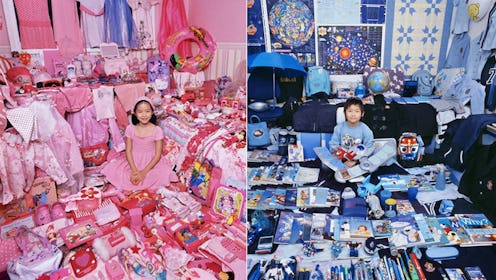
We’ve been talking a lot about gendered color coding in recent years as part of the bigger conversation about gender equality — but if a picture is worth a thousand words, nothing drives home the point better than South Korean photographer JeongMee Yoon’s “Pink and Blue Project.” The thought-provoking photo series depicts girls and boys with their belongings, with the girls surrounded by a sea of pink and the boys swallowed up by a mountain of blue. Inspired by her five-year-old daughter’s obsession with pink toys, clothing, and other objects, Yoon undertook the project to better understand how gendered color coding influences our lives from a young age. The resulting photographs explore this phenomenon in a variety of cultures; they also, as Yoon writes on her website, raise questions about “the relationship between gender and consumerism, urbanization, the globalization of consumerism, and the new capitalism.”
As Yoon found in her research, the color pink wasn’t always associated with femininity; indeed, blue was once the traditional color for girls, while pink, viewed as a lighter shade of red, was considered more masculine and better suited to boys (side note: Does anyone else think of Red vs. Blue’s hapless Private Donut in conjunction with the phrase “light red?”). While this isn’t exactly new information — Peggy Orenstein wrote about it several years ago in her excellent book Cinderella Ate My Daughter — it’s worth noting. According to Yoon, the switch happened fairly recently; it was only after the second World War that pink took on “girly” qualities and blue “boyish” ones.
“The subjects’ expressions and poses are very important elements in my pictures,” Yoon told Slate about the project. “I ask each model to sustain a blank, neutral expression to underline an ‘objectification’ of each child, and I request various poses to heighten the differences in gender and personal characteristics among my subjects.” She added, “I also ask for feminine and masculine expressions and poses of them.” The types of objects, too, show a clear division: The girls’ toys and books focused on fashion, beauty, cooking, and other domestic activities, while those of the boys centered on robots, dinosaurs, and other science-y pursuits. In each photograph, these objects are arranged with the smallest ones in the foreground to give the images a “crowded” look.
The Huffington Post noted that the photographs are both “adorable and unsettling,” and you know what? I think they’re right. Yes, the kids and their prized possessions are super cute; but as the photographs of them highlights, the pink and blue phenomenon is almost entirely a result of consumer culture. It doesn’t have to be, though, and with so much attention getting drawn to it these days, maybe the pendulum is starting to swing the other way. I have high hopes, for example, for Lego’s female scientist Minifig set; it’s also encouraging to know that Hasbro listened to pleas from kids themselves for a gender-neutral Easy Bake Oven. We can only go up from here, right?
Check out the full "Pink and Blue Project" at Yoon's website.
Images: Courtesy of JeongMee Yoon